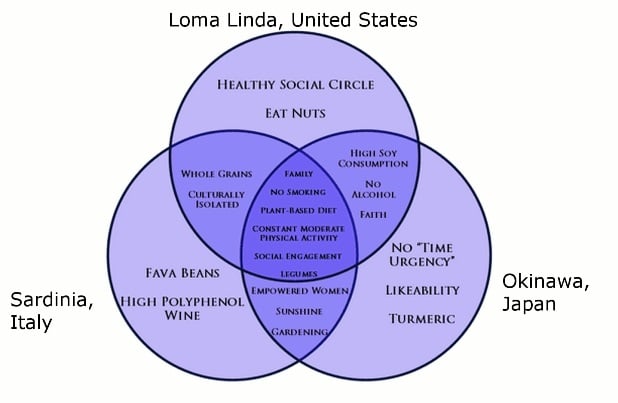In places like Loma Linda, California, Costa Rica, the islands of Okinawa, Sardinia, and Greece’s Ikaria, people are living healthier, happier, and longer than anywhere else in the world.
These locations are called “Blue Zones.”
Dan Buettner, Blue Zone expert, and his team of medical researchers, anthropologists, demographers, and epidemiologists studied these diverse cultures and came up with the Power 9® Principles—the collective lifestyle characteristics employed by centenarian cultures.

When we compare the lifestyles of centenarians with ancient Ayurvedic lifestyle practices, we find some strong similarities:
1. Blue Zone practice: Move naturally! None of the people living in Blue Zones belong to gyms, compete in triathlons, or work out, but they all move naturally throughout the day.
Ayurveda: Ayurveda suggests exercising to only 50 percent of your capacity. Nose breathing exercise and yoga, as written in my book, Body, Mind and Sport, are two strategies to infuse modern workouts with ancient longevity wisdom.
2. Blue Zone practice: Purpose! Centenarians live for something more than just surviving or making money. There is a more profound purpose that gives deeper meaning and joy to their lives.
Ayurveda: The Law of Dharma is the law of purpose. Finding one’s dharma or one’s purpose in life is given major emphasis in an Ayurvedic lifestyle.
3. Blue Zone practice: Downshift! Blue Zone people do not work 60 or 80-hour work weeks, eat in their cars or front of their computers, and go, go, go. They take time each day to socialize, pray, nap, and relax.
Ayurveda: Yoga, breathing, meditation, and prayer are the numerous ways an Ayurvedic lifestyle embraces the need to downshift, chill, smell the roses and be present.
4. Blue Zone practice: The 80 percent rule, which is still practiced by the Okinawans, is to eat until you are only 80 percent full. Blue Zoners tend to eat their main meal at midday and finish eating for the day in the late afternoon or early evening.
Ayurveda: An Ayurvedic lifestyle suggests eating only until your stomach is three-quarters full. Eating is done only in a relaxed environment (never on the run), and the biggest meal is at midday with early and small suppers—all Blue Zone practices!
5. Blue Zone practice: Those living in the Blue Zone follow a plant-slanting diet. They eat a predominately plant-based, non-processed food diet with very little meat. Most eat small amounts of meat—just five times a month. The American centenarians in Loma Linda, California are vegetarians as part of their Seventh Day Adventist religious beliefs.
Ayurveda: Ayurveda also suggests a plant-based diet, and has done for thousands of years. Meat in Ayurveda is a medicine and is used only as such.
6. Blue Zone practice: Wine at five. One way many Blue Zone people downshift is by having a small glass of wine around 5:00 p.m. This helps relax and unwind and, of course, de-stress. Generally, the Adventists in Loma Linda avoid alcohol.
Ayurveda: Alcohol is considered dulling for the mind in Ayurveda, so the wine at 5:00 p.m. ritual is replaced with relaxation techniques like yoga, breathing, or meditation. Bottom-line: we need to turn down the stress volume on a daily basis.
7. Blue Zone: These people find their “right tribe”—a group of friends that we hang and socialize with who are like-minded and support and practice healthy habits.
Ayurveda: This is called sattva in Ayurveda. An Ayurvedic lifestyle includes immersing yourself in a sattvic environment, with people who are healthy, kind, and willing to be loving as opposed to needing to be loved.
8. Blue Zone: Most Blue Zoners belong to a faith-based community. Domination doesn’t apply. As tribal people, we thrive and feel safe in communities of like-minded people.
Ayurveda: While Ayurveda is not a religion by any means, it comes from India, where worship is a natural part of daily life. Regularly loving a “God” helps all of us love more freely, be compassionate, and giving to others.
9. Blue Zone: Loved ones come first. Centenarians live with their extended families. There are no old folks homes. The elderly are revered for their wisdom and are looked up to in society.
Ayurveda: When a couple is married in India, the wife moves into the home with the parents of the groom. From there, grandparents and great grandparents are respected, as they are the kings and queens of the castle.
Blue Zone research has confirmed that there are strategies and lifestyle practices that have been in place for thousands of years. Those that we still see intact in the Blue Zones are positive proof that this ancient wisdom can deliver more fruit than just years to anyone willing to try.
The Blue Zone study is one that we should all be familiar with. It’s not just about living long. It is more about living happily, in peace, and “living the dream”—not the American dream to be rich by 40, but to fully enjoy and be grateful for such a precious life.
~
Author: Dr. John Douillard
Image: Wikimedia; Nicholas Wang/Flickr
Editor: Catherine Monkman
Copy Editor: Yoli Ramazzina
Social Editor: Waylon Lewis


 Share on bsky
Share on bsky





Read 3 comments and reply